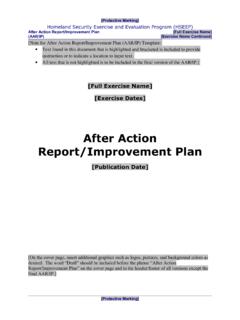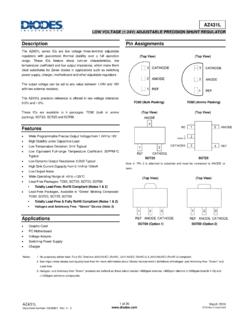Transcription of FactSheet
1 1 FactSheetUnderstanding the HazardInternal combustion engines, whether fueled by gasoline, diesel, propane, natural gas, or other fuels, can act as ignition sources. Examples include: Stationary engines such as compressors, generators and pumps. Mobile equipment or transports such as vans, trucks, forklifts, cranes, well servicing equipment, drilling rigs, excavators, portable generators and welding trucks. Contractor vehicles and motorized equipment. Emergency response vehicles such as fire engines and ambulances. Vehicle-mounted engines on vacuum trucks, tanker trucks and waste haulers. Small portable engines such as mowers, blowers, generators, compressors, welders and pumps. This includes hand tools unrelated to a process, such as chain saws, brought in by combustion engines require a specific fuel-to-air ratio to work properly. Air enters the engine through the intake that leads to the combustion chambers (cylinders).
2 If employers allow internal combustion engines in areas where flammable vapors or gases exist, then the vapors and gases can enter the cylinders of the engine along with the air. Additional flammable material in the cylinders provides an external fuel source and increases the fuel-to-air ratio in the engine. Changes in the fuel-to-air ratio create ignition hazards by: Elevating engine operating temperatures. Increasing the fuel-to-air ratio causes an increase in the energy output which results in increased surface and exhaust temperatures. internal Combustion Engines as Ignition Sources internal combustion engines present an ignition hazard when used in facilities processing flammable liquids and gases. If flammable vapors or gases are released in these facilities, an internal combustion engine could ignite the flammable materials with catastrophic consequences. Investigations by OSHA and the Chemical Safety Board (CSB) document a history of fires and explosions at workplaces (oilfields, refineries, chemical plants, and other facilities) where an internal combustion engine was identified as or suspected to be the source of Increasing the fuel-to-air ratio also causes pre-ignition within internal combustion engines.
3 Pre-ignition occurs when a fuel-rich mixture in the cylinder ignites before the spark plug fires. Pre-ignition creates damaging pressure surges and higher engine surface and exhaust system temperatures. If the temperature of the surface of the engine in contact with the fuel/air mixture reaches the autoignition temperature of that mixture, a fire or explosion will Creating sparks. Fuel-rich conditions in an engine can result in incomplete combustion. An explosion at a refinery site killed 15 and injured nearly 200; an idling diesel pickup truck was the most likely ignition : Chemical Safety Board 1 From Bureau of Labor Statistics and OSHA Integrated Management Information System (IMIS) databases, and CSB reports 2003 2010. 2 The autoignition temperature of a chemical is the lowest temperature at which an air mixture of the chemical will ignite without a spark or uncombusted fuel from the cylinders enters the exhaust system, it can ignite due to the hot surface, discharging sparks and flames (backfire).
4 These can ignite flammable vapors and gases in the surrounding area. Causing overspeed and runaway engines. Overspeed occurs when flammable vapors and gases in the intake air cause engines to run faster than designed. This increases the wear and tear on the engine, causing overheating and risking autoignition. If allowed to continue, overspeed can result in mechanical failure causing the engine to blow apart, igniting flammable materials in the area and causing a flash fire or explosion. For a gasoline engine, overspeed is stopped by turning off the ignition switch, which shuts down the ignition source (spark plugs) in the cylinders. This is not the case for diesel engines. Diesel engines do not use spark plugs; turning off the engine ignition switch does not shut down the ignition source. Stopping the fuel supply is also ineffective because the fuel is present in the intake air. The only way to prevent mechanical failure and possible explosion is to cut off the intake air supply, using systems such as automatic engine overspeed shutdown devices.
5 Preventing Engines from Becoming Ignition SourcesWorkplace Evaluation Identify areas where flammable liquids or gases are used or stored. Evaluate where internal combustion engines are located. Assess contractor use of internal combustion engines in flammable material possible, do not install permanently-mounted internal combustion engines in areas where flammable vapors or gases could be present. If employers cannot remove internal combustion engines from areas processing flammable materials, then the following preventive measures should be used. These measures include administrative procedures for the safe use of portable or mobile equipment with internal combustion Measures to Reduce Risk Ensure that materials and equipment are stored and used in accord with OSHA standards such as:o 29 CFR or 29 CFR , Flammable liquids; o 29 CFR , Spray finishing using flammable and combustible materials; o 29 CFR or 29 CFR , Process safety management of highly hazardous chemicals;o 29 CFR , Powered industrial trucks.
6 Ensure that worksite safety programs and safe work permit systems:o Address internal combustion engines as ignition sources; o Evaluate and establish acceptable areas, boundaries, and entry routes for mobile Three workers were killed and four injured in a fire resulting from a runaway diesel : Chemical Safety BoardThe OSHA General Industry and Construction standards contained in Subparts S and K (29 CFR and 29 CFR ) of the Code of Federal Regulations (CFR) define hazardous (classified) locations as areas with: Flammable gases or vapors (Class I) Combustible dust (Class II) Easily-ignitable fibers (Class III)In Class I locations, an installation must be classified as using the division classification system complying with paragraphs (c), (d), (e), and (f), or using the zone classification system specified in paragraph (g), of 29 CFR or 29 CFR idling diesel pickup truck believed to have ignited a vapor cloud from a nearby process.
7 Chemical Safety Board3internal combustion engines based on applicable standards and recognized and generally accepted good engineering practices;o Mark and enforce acceptable traffic routes through hazardous (classified) locations;o Account for special procedures, which might include the use of portable gas monitors, or emergency evacuation routes for vehicles. Use other preventive measures such as:o Installing automatic overspeed shutdown devices on permanently-mounted Installing intake flame arrestors and exhaust system spark arrest systems on permanently mounted Installing flammable gas and vapor detectors in processing Installing shutdown systems (positive air shut-off for diesel or ignition kill for gasoline), intake flame arrestor, exhaust system spark arrest, or other appropriate protective systems3 for mobile internal combustion Using a safe work permit system to control mobile combustion engine access into areas that could contain flammable vapors and gases.
8 O Using a safe work permit system to control the use of open flames and spark-producing operations and equipment ( , welding, grinding, brazing, etc.)TrainingProvide training to workers and contractors on hazards in areas that contain flammable vapors and gases. The training should include instruction on: Hazards of internal combustion engines as ignition sources and the specific worksite areas that are subject to these hazards. Areas, boundaries and acceptable routes for mobile engines, and applicable facility safety rules. Instruct workers to avoid driving in areas where flammable vapors and gases may be present, to stay on acceptable routes, and to follow site procedures for safe access in areas where flammable materials are being processed. Signs and hazards of flammable vapor and gas clouds, and associated precautions. Signs and hazards of internal combustion engine overspeed and runaway. Emergency procedures for flammable materials emergencies, including response to engine overspeeds and and Resources In addition to following applicable OSHA standards, employers should also refer to the American Petroleum Institute (API), the National Fire Protection Association (NFPA), and other applicable industry and consensus standards, which provide helpful OSHA Standard 29 CFR , Flammable liquids: 29 CFR (e)(6)(i), (f)(6), and (h)(7)(i)(A), Sources of 29 CFR , Spray Finishing Using Flammable and Combustible 29 CFR (c)(2)(i), (ii), Power-operated industrial trucks shall not be used in atmospheres containing hazardous concentration of acetylene, butadiene, ethylene oxide, and hydrogen.
9 Metal dusts .. For other listed chemicals, only certain unit ratings are allowed. See the standard for more 29 CFR , Process Safety Management of Highly Hazardous Chemicals. 5. OSHA - Petroleum Refinery Process Safety Management National Emphasis Program (CPL 03-00-010, dated 8/18/2009). Page A-55, Motorized Equipment. Does the employer have a safe work practice which it implements One of two vacuum truck diesel engines believed to be the ignition source for a fatal fire at an open air collection : Chemical Safety BoardThe Process Safety Management (PSM) standard (29 CFR ) applies to processes in facilities that have flammable liquids or gases on site in one location in a quantity of 10,000 pounds or more. For covered processes, the PSM standard addresses controlling ignition sources primarily by requiring employers to: Compile written process safety information for working with hazardous chemicals, including identifying areas where flammable materials are or may be present, 29 CFR (d).
10 Complete a process hazard analysis that addresses the hazards of the process, including control of ignition sources such as internal combustion engines, 29 CFR (e). Develop and implement safe work practices, including control of vehicle access to process areas, 29 CFR (f)(4). Develop and implement written procedures (f) and training for operators (g), maintenance personnel (j), and contractors (h), 29 CFR (f), (g), (h), and (j). Control hot work, 29 CFR (k).3 Forklifts require specific unit ratings to be used. See 29 CFR motorized equipment to enter operating units and adjacent roadways? 6. Mine Safety and Health Administration (MSHA) Standard 30 CFR Diesel Engine Technical Requirements. Requires explosion-proof design and a safety shutdown system, as well as intake flame arrest and an exhaust system spark arrest system. See also MSHA Standard 30 CFR Engine Intake System. 7. Department of Interior, Materials Management Services (MMS) 30 CFR , , and (b)(5)(ii).















